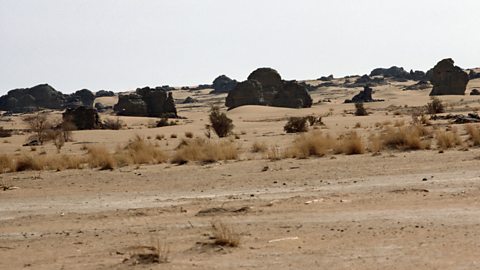Case study - the impact of drought in a developing country: the Sahel
The Sahel is located directly south of the Sahara desert and stretches from the east to the west of Africa.
The Sahel is semi-aridExtremely dry., receiving between 250 and 450 mm of rainfall in total in an average year, however it only falls in one or two months. This region provides Africa with food and cash crops such as millet and cotton.
Since the 1970s, the Sahel has experienced drought conditions on a regular basis. This is down to physical and human factors:
- overgrazingWhen land cannot sustain the number of animals that are feeding from it. and deforestationThe cutting down of trees and forests to allow a different land use. on marginal landLand that is difficult to develop and yields little profit. can lead to desertificationThe spread of desert conditions in arid regions due to human activities, drought or climate change.. With less vegetation there is less transpirationThe loss of water from leaves by evaporation through the stomata. and evaporationThe process in which a liquid changes state and turns into a gas. from the soil, causing less rainfall.
- Changes in surrounding ocean temperature – the temperatures of the south Atlantic and Indian Oceans increased, with a smaller temperature gap between land and ocean, and monsoonA strong seasonal wind bringing heavy rain. rains were reduced.
- Some scientists believe climate change has reduced rainfall or made it less predictable.
The social and economic impacts of drought in the Sahel
Social impacts
- Subsistence farmers' crops fail and livestock dies. This can lead to famine and hunger.
- Commercial farms growing cash crops such as cotton lose income, which may cause unemployment.
- With less food being grown and an increase in demand, food prices increase.
- Increased soil erosion makes the land less fertile, creating a long-term issue for the farming community.
- Clean water is not available for people to drink, increasing the use of contaminated water and diseases such as cholera.
- People (usually women and children) travel further to find water, which means children miss school and the carrying of heavy loads can lead to back problems.
Environmental impacts
- Seasonal rivers and water holes dry up, so organisms which live in them or rely on them for water may die.
- Vegetation dies causing animals depending on it for food or shelter to perish or migrate.
- Increased soil erosion. Eroded material is washed into rivers or water holes resulting in contamination.

The semi-arid landscape of the Sahel
Attempted solutions
- Encouraging farmers to grow drought-resistant crops.
- Improving knowledge and understanding of droughts across the region by launching the Africa Climate Exchange
- Use of drip irrigation systems to reduce water usage.
- Lines of rocks are placed across the land to slow flowing rainwater and encourage the depositionWhen material is deposited or left behind, eg when a river loses its energy and is unable to carry its load any further, or waves move sand onto a beach but lack the energy to carry it away. of sediments (rich in nutrients). This is a cost-effective option.